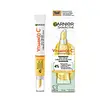What's inside
What's inside
 Key Ingredients
Key Ingredients

 Benefits
Benefits

 Concerns
Concerns

 Ingredients Side-by-side
Ingredients Side-by-side

Water
Skin ConditioningGlycerin
HumectantCyclomethicone
EmollientMethylpropanediol
SolventGlyceryl Stearate
EmollientDimethicone
EmollientCaprylic/Capric Triglyceride
MaskingCetearyl Alcohol
EmollientOctyldodecanol
EmollientC12-15 Alkyl Benzoate
AntimicrobialHydrogenated Vegetable Oil
EmollientTalc
AbrasiveTapioca Starch
1,2-Hexanediol
Skin ConditioningUbiquinone
AntioxidantCreatine
Skin Conditioning1-Methylhydantoin-2-Imide
Skin ConditioningPotassium Cetyl Phosphate
EmulsifyingCera Microcristallina
Emulsion StabilisingParaffinum Liquidum
EmollientHydrogenated Palm Glycerides
EmollientAcrylates/C10-30 Alkyl Acrylate Crosspolymer
Emulsion StabilisingCarbomer
Emulsion StabilisingEthylhexylglycerin
Skin ConditioningTrisodium EDTA
Sodium Hydroxide
BufferingPhenoxyethanol
PreservativeBenzoic Acid
MaskingCI 77891
Cosmetic ColorantWater, Glycerin, Cyclomethicone, Methylpropanediol, Glyceryl Stearate, Dimethicone, Caprylic/Capric Triglyceride, Cetearyl Alcohol, Octyldodecanol, C12-15 Alkyl Benzoate, Hydrogenated Vegetable Oil, Talc, Tapioca Starch, 1,2-Hexanediol, Ubiquinone, Creatine, 1-Methylhydantoin-2-Imide, Potassium Cetyl Phosphate, Cera Microcristallina, Paraffinum Liquidum, Hydrogenated Palm Glycerides, Acrylates/C10-30 Alkyl Acrylate Crosspolymer, Carbomer, Ethylhexylglycerin, Trisodium EDTA, Sodium Hydroxide, Phenoxyethanol, Benzoic Acid, CI 77891
Water
Skin ConditioningGlycerin
HumectantDimethicone
EmollientPrunus Armeniaca Kernel Oil
MaskingNiacinamide
SmoothingAcrylamide/Sodium Acryloyldimethyltaurate Copolymer
Emulsion StabilisingSilica
AbrasiveCI 77891
Cosmetic ColorantIsohexadecane
EmollientDimethicone/Vinyl Dimethicone Crosspolymer
Skin ConditioningHydroxypropyl Tetrahydropyrantriol
Skin ConditioningCaffeine
Skin ConditioningSynthetic Fluorphlogopite
Propylene Glycol
HumectantPhenoxyethanol
PreservativeAcrylates/C10-30 Alkyl Acrylate Crosspolymer
Emulsion StabilisingTocopherol
AntioxidantChlorphenesin
AntimicrobialPolysorbate 80
EmulsifyingAscorbyl Glucoside
AntioxidantTriethanolamine
BufferingCI 77492
Cosmetic ColorantTrisodium Ethylenediamine Disuccinate
Musa Sapientum Fruit Extract
Skin ConditioningAdenosine
Skin ConditioningHydrolyzed Hyaluronic Acid
HumectantHydroxyethylpiperazine Ethane Sulfonic Acid
BufferingMica
Cosmetic ColorantSorbitan Oleate
EmulsifyingMusa Paradisiaca Fruit Juice
Skin ConditioningAnanas Sativus Fruit Extract
Skin ConditioningCitric Acid
BufferingSodium Benzoate
MaskingDisodium Stearoyl Glutamate
CleansingLactic Acid
BufferingTin Oxide
AbrasivePotassium Sorbate
PreservativeAluminum Hydroxide
EmollientWater, Glycerin, Dimethicone, Prunus Armeniaca Kernel Oil, Niacinamide, Acrylamide/Sodium Acryloyldimethyltaurate Copolymer, Silica, CI 77891, Isohexadecane, Dimethicone/Vinyl Dimethicone Crosspolymer, Hydroxypropyl Tetrahydropyrantriol, Caffeine, Synthetic Fluorphlogopite, Propylene Glycol, Phenoxyethanol, Acrylates/C10-30 Alkyl Acrylate Crosspolymer, Tocopherol, Chlorphenesin, Polysorbate 80, Ascorbyl Glucoside, Triethanolamine, CI 77492, Trisodium Ethylenediamine Disuccinate, Musa Sapientum Fruit Extract, Adenosine, Hydrolyzed Hyaluronic Acid, Hydroxyethylpiperazine Ethane Sulfonic Acid, Mica, Sorbitan Oleate, Musa Paradisiaca Fruit Juice, Ananas Sativus Fruit Extract, Citric Acid, Sodium Benzoate, Disodium Stearoyl Glutamate, Lactic Acid, Tin Oxide, Potassium Sorbate, Aluminum Hydroxide
 Reviews
Reviews

Ingredients Explained
These ingredients are found in both products.
Ingredients higher up in an ingredient list are typically present in a larger amount.
Acrylates/C10-30 Alkyl Acrylate Crosspolymer is a synthetic polymer. It is used to thicken and improve the texture of products. Due to its properties, it can prevent water and oil ingredients from separating.
Ci 77891 is a white pigment from Titanium dioxide. It is naturally found in minerals such as rutile and ilmenite.
It's main function is to add a white color to cosmetics. It can also be mixed with other colors to create different shades.
Ci 77891 is commonly found in sunscreens due to its ability to block UV rays.
Learn more about CI 77891Dimethicone is a type of synthetic silicone created from natural materials such as quartz.
What it does:
Dimethicone comes in different viscosities:
Depending on the viscosity, dimethicone has different properties.
Ingredients lists don't always show which type is used, so we recommend reaching out to the brand if you have questions about the viscosity.
This ingredient is unlikely to cause irritation because it does not get absorbed into skin. However, people with silicone allergies should be careful about using this ingredient.
Note: Dimethicone may contribute to pilling. This is because it is not oil or water soluble, so pilling may occur when layered with products. When mixed with heavy oils in a formula, the outcome is also quite greasy.
Learn more about DimethiconeGlycerin is already naturally found in your skin. It helps moisturize and protect your skin.
A study from 2016 found glycerin to be more effective as a humectant than AHAs and hyaluronic acid.
As a humectant, it helps the skin stay hydrated by pulling moisture to your skin. The low molecular weight of glycerin allows it to pull moisture into the deeper layers of your skin.
Hydrated skin improves your skin barrier; Your skin barrier helps protect against irritants and bacteria.
Glycerin has also been found to have antimicrobial and antiviral properties. Due to these properties, glycerin is often used in wound and burn treatments.
In cosmetics, glycerin is usually derived from plants such as soybean or palm. However, it can also be sourced from animals, such as tallow or animal fat.
This ingredient is organic, colorless, odorless, and non-toxic.
Glycerin is the name for this ingredient in American English. British English uses Glycerol/Glycerine.
Learn more about GlycerinPhenoxyethanol is a preservative that has germicide, antimicrobial, and aromatic properties. Studies show that phenoxyethanol can prevent microbial growth. By itself, it has a scent that is similar to that of a rose.
It's often used in formulations along with Caprylyl Glycol to preserve the shelf life of products.
Water. It's the most common cosmetic ingredient of all. You'll usually see it at the top of ingredient lists, meaning that it makes up the largest part of the product.
So why is it so popular? Water most often acts as a solvent - this means that it helps dissolve other ingredients into the formulation.
You'll also recognize water as that liquid we all need to stay alive. If you see this, drink a glass of water. Stay hydrated!
Learn more about Water